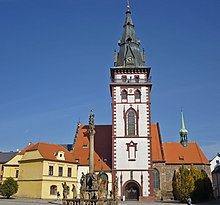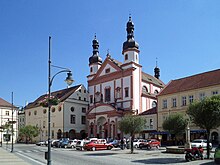Chomutov
Chomutov | |
|---|---|
 General view from the northwest | |
|
| |
| Coordinates: 50°27′40″N 13°25′0″E / 50.46111°N 13.41667°E | |
| Country | |
| Region | Ústí nad Labem |
| District | Chomutov |
| First mentioned | 1252 |
| Government | |
| • Mayor | TBD |
| Area | |
| • Total | 29.25 km2 (11.29 sq mi) |
| Elevation | 340 m (1,120 ft) |
| Population (2024-01-01)[1] | |
| • Total | 47,023 |
| • Density | 1,600/km2 (4,200/sq mi) |
| Time zone | UTC+1 (CET) |
| • Summer (DST) | UTC+2 (CEST) |
| Postal codes | 430 01, 430 03, 430 04 |
| Website | www |
Chomutov (Czech pronunciation: [ˈxomutof] ; German: Komotau) is a city in the Ústí nad Labem Region of the Czech Republic. It has about 47,000 inhabitants. There are almost 80,000 inhabitants in the city's wider metropolitan area. The historic city centre is well preserved and is protected by law as an urban monument zone.
Administrative division
[edit]Chomutov is made up of only one administrative part and is the only such Czech city.[2]
Etymology
[edit]The name is derived from the personal name Chomút/Chomout, meaning "Chomout's (court)". The word chomút, from which the personal name arise, denoted a clumsy person in Old Czech.[3]
Geography
[edit]Chomutov is located about 78 kilometres (48 mi) northwest of Prague. It lies on the Chomutovka River in the Ore Mountains Foothills. The surface is mostly flat with some hills in the north and southeast of the city. The highest point of the municipal territory is Hůrka 581 m (1,906 ft), a hill on the northwestern municipal border.
There are several bodies of water on the outskirts of the city. Kamencové Lake and Velký Otvický Pond are used for recreational purposes.
History
[edit]The first written mention of Chomutov is a deed of gift from 1252, when it came into the possession of the Teutonic Order. The Gothic church of St. Catherine built during that era still stands to this day. In 1396 Chomutov received a town charter, and in 1416 the knights sold both the town and the lordship to Wenceslaus IV.[4]
On 16 March 1421, the town was stormed, sacked and burned by the Taborites. After several upheavals and changes of ownership, Chomutov was taken by Popel of Lobkowitz in 1588, who established Jesuit rule, leading to trouble between the Protestant citizens and the town's new overlord.[5] In 1594 the feudal lordship fell to the crown, and in 1605 the town purchased its freedom and was made a royal city. After the Thirty Years' War, Chomutov stagnated.[6] Rapid development did not come until the second half of the 19th century, with advances in the mining and heavy industries.
By 1938, Chomutov had over 30,000 inhabitants. It had a population comprising about 95% ethnic Germans. A very small Jewish population (444 in 1930 – 1.3% of the total population) came under increasing pressure, and Chomutov was declared "Judenrein" on 23 September 1938 by the increasingly pro-Nazi administration.[7] A week later, Chomutov and its surrounding districts were annexed by Nazi Germany as a result of the 1938 Munich Agreement and administered as part of the Reichsgau Sudetenland.
After 1945, the previous population, German by a large majority, was expelled.[8] Industrial facilities and large high-rise housing projects were then built to redevelop the area. In the late 1970s an urban settlement was built, linking Chomutov with its neighbouring Jirkov. Following the Velvet Revolution of 1989, the heavy industry significantly decreased its activity, but the environment in and around the town has been visibly improved. The leisure facilities of the area were emphasised, notably Alum Lake, the Zoopark Chomutov[9] and the Bezručovo Valley recreational area.
Since 1 July 2006, Chomutov has been a statutory city.
Demographics
[edit]
|
|
| ||||||||||||||||||||||||||||||||||||||||||||||||||||||
| Source: Censuses[10][11] | ||||||||||||||||||||||||||||||||||||||||||||||||||||||||
Economy
[edit]The largest employer with headquarters in Chomutov is Severočeské doly, a lignite mining company with more than 2,500 employees. Among other large industrial companies based in the city is Parker Hannifin Industrial, a manufacturer of hydraulic and pneumatic systems.[12]
Transport
[edit]
The D7 motorway from Prague to the Czech-german border in Hora Svatého Šebestiána runs through the western part of Chomutov. In Chomutov it crosses with the I/13 road (part of the European route E442) from Karlovy Vary to Liberec.
Chomutov is located at the crossroads of several important railway lines: Prague–Cheb, Plzeň–Most, Děčín–Kadaň and Rakovník–Jirkov. The city is served by two train station: Chomutov and Chomutov město.[13]
Public transport
[edit]Transport around Chomutov is operated by buses since 1995 and also by trolleybuses.[14] The trolleybus net connects Chomutov with neighbouring Jirkov. They jointly operate a transport company (Dopravní podnik měst Chomutova a Jirkova).[15]
Sport
[edit]Chomutov is home to the ice hockey club Piráti Chomutov, playing in the second tier, and association football club FC Chomutov, playing in lower amateur tiers.
The city has two sport areas: Zadní Vinohrady, where the water park, football and athletics stadium are located,[16] and Domovinka in the area of the former motorcycle speedway stadium, with two multifunctional courts for tennis, basketball and volleyball and artificially constructed hills for sledding and bobsledding.[17]
Sights
[edit]

Since 1992, the historical city centre has been urban monument zone. The historical centre is in the shape of an oblong, and is surrounded by arcades. The 1. máje Square with its Baroque Column of the Holy Trinity by Ambrož Laurentis from 1697 is banked by seven statues of saints built between 1725 and 1732.[18]
The city hall is situated in the northwest side and it used to be a commendam until 1607. The city hall is situated next to the Church of St. Catherine built in early Gothic style and finished in 1281.
On the opposite side there is the Church of Assumption of the Virgin Mary, built in late Gothic style between 1518 and 1542. The church is situated next to the 53.7 m (176 ft) tall dominant of the city, the City Tower. The tower was renovated after the fire in 1525 and rebuilt to neo-Gothic style in 1874. Nowadays it is used as an observation tower.[19]
At the end of the south side there is the Baroque Church of Saint Ignatius with two towers on the north frontage. The church was built for Jesuits by Carlo Lurago between 1663 and 1668. The building called Špejchar from the 17th century was used by Jesuits as earlier church and it adjoins the east side of the Church of St. Ignatius. Nowadays it is used as a gallery.[18]
There is the Jesuit college south of the Church of St. Ignatius from the 16th and 17th century, which nowadays houses the city museum. The most important building from the Gothic residential houses is the late Gothic house No. 9.
The Zoopark Chomutov borders with the Alum Lake on its north side. The zoo is focused mostly on breeding European and mainly domestic wild animals (wolf, european bison, etc.). The zoo is the largest in the country by area, with an area of 112 hectares (280 acres).[20]
Bezručovo Valley is a deep, 13 km (8 mi) long woody valley of the Chomutovka River, beginning in the northern part of the territory of Chomutov. It is a popular place for trips.[21]
Notable people
[edit]- Matthäus Aurogallus (1490–1543), scholar
- Franz Josef von Gerstner (1756–1832), mathematician
- Ernst Fischer (1899–1972), Austrian politician, writer
- Hans Goldmann (1899–1991), Austrian-Swiss ophthalmologist and inventor, rector of the University of Bern
- Erich Heller (1911–1990), British philosopher and literary scholar
- Marian Korn (1914–1987), printmaker
- Ruth Maria Kubitschek (1931–2024), German actress
- Uschi Nerke (born 1944), German TV host
- Petr Klíma (1964–2023), ice hockey player
- Pavla Hamáčková-Rybová (born 1978), pole vaulter
- Simona Kubová (born 1991), swimmer
Twin towns – sister cities
[edit] Annaberg-Buchholz, Germany
Annaberg-Buchholz, Germany Bernburg, Germany
Bernburg, Germany Trnava, Slovakia
Trnava, Slovakia
Gallery
[edit]-
Old poorhouse building
-
City theatre
-
District court building
-
Jesuit college
-
City block
-
View of the 1. máje Square
-
City hall and the Church of St. Catherine
References
[edit]- ^ "Population of Municipalities – 1 January 2024". Czech Statistical Office. 2024-05-17.
- ^ "Části obcí". Územně identifikační registr ČR (in Czech). Retrieved 2023-11-14.
- ^ "Chomutov" (in Czech). Czech Radio. 2015-03-25. Retrieved 2024-01-12.
- ^ "Počátky města" (in Czech). City of Chomutov. Retrieved 2021-05-27.
- ^ "Husitské války" (in Czech). City of Chomutov. Retrieved 2021-05-27.
- ^ "Historie Chomutova – královské město a období třicetileté války" (in Czech). City of Chomutov. Retrieved 2021-05-27.
- ^ "CHOMUTOV: Bohemia - czech-republic- - International Jewish Cemetery Project". iajgsjewishcemeteryproject.org. Archived from the original on 2014-10-17. Retrieved 2014-11-08.
- ^ de Zayas, Alfred-Maurice (1994). A Terrible Revenge (2nd ed.). New York.
{{cite book}}: CS1 maint: location missing publisher (link) - ^ "Zoopark Chomutov". Zoopark Chomutov. Retrieved 2021-05-27.
- ^ "Historický lexikon obcí České republiky 1869–2011" (in Czech). Czech Statistical Office. 2015-12-21.
- ^ "Population Census 2021: Population by sex". Public Database. Czech Statistical Office. 2021-03-27.
- ^ "Registr ekonomických subjektů". Business Register (in Czech). Czech Statistical Office. Retrieved 2024-05-11.
- ^ "Detail stanice Chomutov" (in Czech). České dráhy. Retrieved 2024-01-12.
- ^ "Trolleybuses in Chomutov". Tram.rusign.com. Archived from the original on 2013-06-07. Retrieved 2014-11-08.
- ^ "Úvodní stránka - Dopravní podnik měst Chomutova a Jirkova". Dpchj.cz. Retrieved 2014-11-08.
- ^ "Areál na Zadních Vinohradech" (in Czech). City of Chomutov. Retrieved 2024-05-11.
- ^ "Sportovní areál Domovinka" (in Czech). City of Chomutov. Retrieved 2024-05-11.
- ^ a b "Historické památky" (in Czech). City of Chomutov. Retrieved 2021-05-27.
- ^ "Městská věž". Atlas Česka (in Czech). Retrieved 2021-05-27.
- ^ "Zoopark Chomutov" (in Czech). Zoopark Chomutov. Retrieved 2021-09-22.
- ^ "Bezručovo údolí". ceskehory.cz (in Czech). Retrieved 2024-08-13.
- ^ "Partnerská města" (in Czech). City of Chomutov. Retrieved 2023-08-02.










